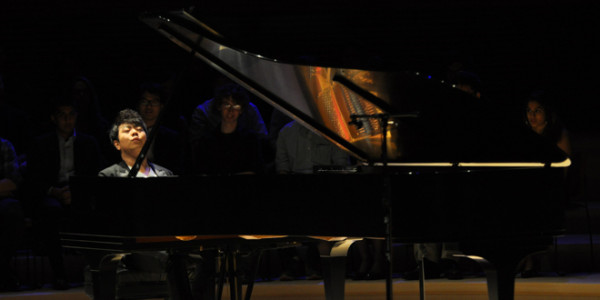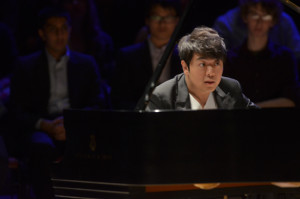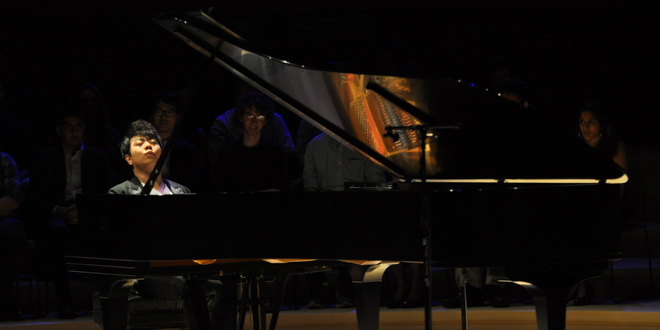
Lang Lang began the night with Bach’s well-known Italian Concerto in F Major, effortlessly capturing the intricacies of Bach; the complex fingerwork and voicing required by the concerto didn’t pose the slightest problem to his obvious enjoyment of the piece. Lang Lang immediately drew the audience in, clearly bringing out the upbeat melody of the first movement against the complexities of the accompaniment. His interpretation of the concerto included pedal, avoiding the characteristic dryness of Bach due to his writing for harpsichord rather than piano. Adding pedal created a fuller sound, despite the detached style, and made the piece more accessible for the audience, which applauded before Lang Lang even finished playing the last notes.
While some artists might be thrown off by audience members sitting less than 20 feet away from them during a performance, Lang Lang was the picture of ease despite the close proximity of a group of Stanford piano students onstage. Upon finishing one movement with a dramatic gesture, Lang Lang jumped into the completely different mood of the next piece within seconds, demonstrating a flexibility not all artists possess.
Tchaikovsky’s “The Seasons,” a collection of 12 shorter pieces representing each month of the year, was next on the program. Lang Lang truly brought the different character of each month to life with his gestures and full body movements, almost caressing the keyboard during “January: Fireside,” tapping his foot eagerly during “September: The Hunt.” Lang Lang used this suite of pieces to showcase his artistic and expressive abilities, in contrast to the fast and technically-impressive playing of the Chopin scherzi later in the program. Nowhere was this more evident than during “May: White Night,” where Lang Lang really took his time, deliberately stretching phrases out and savoring each note of the ritards. Following the cheer of “December: Ballroom Waltz,” the audience got a chance to catch its breath during an intermission before Lang returned with the intensity of Chopin.

It was in the final set of pieces, Chopin’s Four Scherzi, that Lang Lang dazzled the audience with his pure technical brilliance. His smooth fingerwork during the fast passage of Scherzo No. 1 was matched only by his clear and precise chord passages of Scherzo No. 2, especially at the end. The audience literally leapt to its feet before the final, joyous chords had finished ringing, determined to give Lang Lang the applause he deserved for his dramatic performance. And, indeed, each of the Scherzi was filled with Lang Lang’s characteristic, over-the-top gestures, from flinging his hands off the keyboard to excessive head-banging and foot-stomping. Yet these minor visual distractions did not detract from his mastery of the works, in particular his sparkling right-hand passages in Scherzo No. 3. Lang Lang’s last piece was Scherzo No. 4, the most stately, yet still technically demanding, scherzo; his performance brought back his expressiveness and artistry, somewhat absent from the first three scherzi, in a fitting conclusion to the program.
After many rounds of applause, in which he bowed separately to each section of the audience and directed well-deserved applause to the piano, Lang Lang fulfilled the audience’s wish for an encore. In a departure from his absolute focus during the concert, he performed Wolfgang Amadeus Mozart’s well-known Alla Turca, and put on quite a show while doing it. The audience, already chuckling at his choice of song, only smiled more at the impressive yet ridiculous speed at which Lang Lang performed. He also added an element of experimentation to his performance, playing in a staccato style where the audience expected legato notes and exaggerating differences in dynamic with his body and facial expressions.
Lang Lang’s performance was nothing short of incredible. He is an artist who truly loves his craft, and on Friday night, he shared that love with all of us.
Contact Serena Wong at serenaw ‘at’ stanford.edu.
